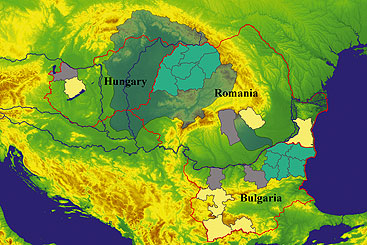Supporting a regional understanding of climate change

Supporting a regional understanding of climate change
The impacts of climate change on global water resources will affect our lives and economies. Scientists around the globe are looking at all the evidence of past and ongoing climate change and using models to come up with predictions for our future environment and weather.

The nations in Central
and Eastern Europe face
triple challenges through
the ongoing economic
and political transition,
continuing vulnerability
to environmental hazards,
and longer-term impacts
of global climate change.
The aim of CLAVIER is
to help cope with these
challenges.
Ongoing and future climate changes are drastically influencing the hydrological cycle and its variability. These changes are most visible in Central and Eastern Europe, with a series of extreme floods hitting the Tisza Basin in 1998-2001 and the Danube River in August 2002 and spring 2006. The transboundary character of the water bodies clearly underlines the necessity to improve flood safety across the whole region, and a number of ambitious projects have been launched in recent years in Hungary, Romania, Slovakia and Ukraine to address these issues. However, to succeed, such efforts must be supported by the reliable assessment of climate change on the regional scale.
CLAVIER
The CLAVIER project is supported by the European Commission‘s 6th Framework Programme under the ‘Thematic Sub-Priority Global Change and Ecosystems’. The key goals:
- investigation of ongoing and future climate changes and their associated uncertainties in Central and Eastern European Countries (CEEC)
- analyses of possible impact of climate changes in CEEC on weather pattern and extremes, air pollution, human health, natural ecosystems, forestry, agriculture and infrastructure as well as water resources
- evaluation of the economic impacts of climate changes on CEEC economies, concentrating on four economic sectors, which are agriculture, tourism, energy supply and the public sector.
In 2006, the European Commission launched the project Climate Change and Variability: Impact on Central and Eastern Europe (CLAVIER) to investigate climate changes and their associated uncertainties in Central and Eastern European countries. The project focuses on Bulgaria, Hungary and Romania, however user groups from all Central and Eastern European countries will benefit from the results.
The CLAVIER research covers a wide range of issues relevant to the potential impact of climate changes, including weather patterns, air pollution, extreme events and water resources. Furthermore, to assess the local and regional impact, the project includes an evaluation of the economic impact on agriculture, tourism, energy supply and the public sector.
Bringing international studies to the regional level. Researchers from six countries and varying disciplines analyse existing data and climate situations from 1951 to 2050. This ensemble of model situations is a cross product of various greenhouse-gas-emission scenarios from the International Panel on Climate Change. “Such an exhaustive combination is designed to evaluate the uncertainties existing in the different stages of regional climate change information,” says Laurent Li of the Institute Pierre Simon Laplace in Paris.
A crucial part of the project is setting up and maintaining the project database, which is important for an interdisciplinary team. “We aim to establish an interface between regional climate models and models or studies focusing on impacts of climate and climate change in Central and Eastern Europe,” says Andreas Gobiet from the Wegener Centre in Graz.
Understanding weather changes. It is generally expected within the climate research community that extreme weather events will be more intense and occur more often. The CLAVIER project has therefore identified 24 indices for extreme events typical for the CLAVIER target regions, mainly based on temperature, precipitation and wind speed. “Weather regimes are a main factor in organising the local weather and climate of Central and Eastern Europe,” says András Horányi of the Hungarian Meteorological Service in Budapest, one of the project’s partners.
Based on the preliminary results of the main investigations, more frequent winter and spring floods on major rivers are expected over the next 40 years, while low flow periods could last longer.

The CLAVIER project focuses on Bulgaria, Hungary and Romania – in particular the Tisza and Arges catchments, as well as the hydrological regime of Lake Balaton. The project’s target regions: cyan – hydrological/ water management; green – agriculture; grey – energy; yellow – tourism.
For more information, please visit: cordis.europa.eu/project/id/37013






